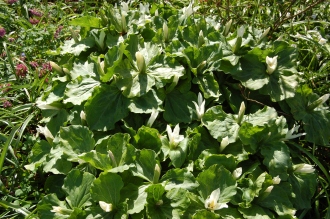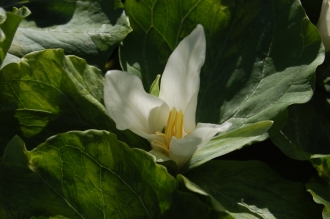Position: Partial shade to shade
Flowering period: Spring
Soil: Moist, well drained
Eventual Height: 40cm
Eventual Spread: 30cm
Hardiness: 6a, 6b, 7b, 8a, 8b
Family: Melanthiaceae
Trillium luteum is a deciduous herbaceous perennial with a clump forming habit. Its dark green leaves have silver/ green mottling, are obtuse to rounded with and entire margins, appear in groups of three and are up to 15cm long. Its fragrant yellow flowers contain three petals, each petal being up to 5cm long and appear terminally. Its roots are thick rhizomes which aids its spread.
Trillium luteum, commonly known as Yellow Wood Trillium, Yellow Wakerobin, is native to east North America. In its native habitat it grows as a ground cover below deciduous trees. Trillium luteum synonymous with Trillium sessile var. luteum.
The etymological root of the binomial name Trillium is derived from the Latin triplum meaning ‘triple’, referring to the three-parted flowers common to the genus. Luteum is from the Latin meaning ‘yellow’.
The landscape architect may find Trillium luteum useful as a low growing ground cover plant suitable for shady locations, particularly under deciduous trees.
Ecologically, Trillium luteum is attractive to pollinating insects. The seed of this plant attracts ants as the elaiosome of the seed evokes their corpse-carrying behavior.
The Royal Horticultural Society have given Trillium luteum their prestigious Award of Garden Merit in 1993.
Trillium luteum prefers moist, humus rich fertile, well-drained soils. It prefers an acid to neutral pH of soil.
Trillium luteum requires little maintenance. Large clumps may be divided in late summer to early autumn.
![]()
Landscape Architecture











